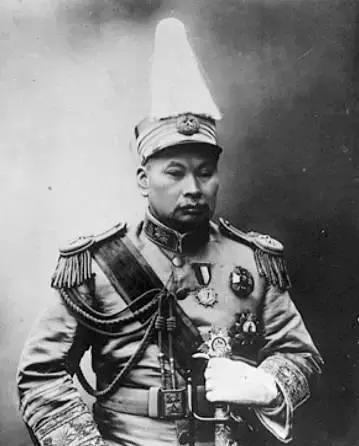For more than a decade, there is an online article that has been widely circulated, the article is called "The Final Outcome of the Twenty-Four Admirals of Beiyang", because its writing style is relatively rare today, so it is very popular in the online self-media. Excerpt a short paragraph:
"Lu Rongting, formerly known as Lu Asong, is a native of Wuming, Guangxi. ...... Xinhai, contrary to the southwest. After Shen Bingkun became the governor of Guangxi and Minyuan, between Yi and Sun Yuan, he sat on the border, and until the Nationalist government cut the domain, Fang lost power and lived in seclusion in Shanghai, and died at the age of seventy. ”

I will not comment on the praise and criticism of the various masters in this article, but the donkey lip and horse mouth that is wrong just by looking at the number of 24 must be corrected.
One of the mistakes, the text is not correct.
The title of the article is about the general, but the content is the crown character general, and the general and the general in the Beiyang period are not the same thing at all.
The general is a first-class military rank, but the general is not a military rank, which was initially an official position, and later evolved into a title, and the nature of the two is completely different. On June 30, 1914, Yuan Shikai ordered the abolition of the governors of the provinces and the establishment of the General's Mansion in the central government, and on July 18, he promulgated the Order on the Establishment of the General's Mansion, which stipulated:
"The General's Office shall appoint the General to the Grand President in a special manner among the Admirals or Lieutenant Generals of the Army and Navy. The title of general is specified by the President. ”
After that, the governor of each province was renamed a general. For some generals with high military merit or high qualifications, they are appointed as generals.
There is a formula here, that is, all those who are appointed as generals must have the rank of general, but generals may not all be appointed as generals. Of the 65 generals in the Beiyang period, only 29 were appointed as generals.
Mistake two, the number is incorrect.
In the Beiyang period, there were 65 generals and 29 generals, and there was no such number as 24.
Since there is none, where did the number 24 come from? It makes people cry and laugh. Originally, the original intention of writing "The Final Ending of the Twenty-Four Admirals of Beiyang" was to establish a biography of the 29-member crowned general, but for some reason, only 24 people were originally written. After the article was published on the Internet, after being reminded, it was found that 5 people were missed, so they added 5 people in the following posts, and 29 people were gathered. However, the author never changed the title, and still named it "Twenty-Four Admirals". Nowadays, too many readers and self-media authors are shallow reading, fragmented reading, more than a thousand words can not be read, they simply did not see the supplement behind, nor did they find out what was going on between the admiral and the general of the Beiyang period and how many people were there, so they were impetuously reprinted or republished, so that this "twenty-four admirals" who were not like donkey lips and horses' mouths became popular on the Internet.
The third mistake is that the Master is wrong.
Although the correct number of 29 generals was reached after supplementation, the author added Yang Zengxin, who was not a general, and Zhang Huaizhi, who was originally a general, was still missed.
Why Yang Zengxin was mistakenly made up, this is probably related to the inscription on Yang Zengxin's tombstone. On Yang's tombstone, the words "General Khotan" are clearly engraved. Do you think that the words carved on the stone are the stele erected in the second year after Yang's death (1929), is that not ironclad evidence?
hehe! Not really. Although this stele is not forged by the present people, the words on the stele are ultimately due to the wrong title caused by the overlap of the customary title with the title of the crowned general, regardless of whether the wrong title is intentional or unintentional.
Yang Zengxin's rank was Army General, with the title "General Khotanese", not "Khotanese General". In the folk, there has always been a habit of calling generals generals, and this is also true today. There is no misunderstanding about the use of this customary title in other periods, and it is very easy to cause misunderstandings when it is used in the Beiyang period. After Yang's death, the inscription on his tombstone reads "General Khotan", which is typical of confusion. For Yang Zengxin, he can be called "Khotanese General" according to the title of the General's Office, and he can also be called "Shangjiang" according to the custom, but it is not possible to graft "Khotan" and "Shangjiang" together, which will undoubtedly cause serious ambiguity. It is most likely a side ball that the tree monumenter deliberately played.
However, this name only appears on the tombstone, not in the public, and people die greatly, so there is no need to be so real. However, as a later historian, it was necessary to understand whether Yang Zengxin was "General Khotan" or "General Khotan", but unfortunately, there are still people who have not understood, or have not tried to understand, or even deliberately pretended not to understand, so this inscription was misread and falsely rumored, and Yang Zengxin was said to be a titled general.